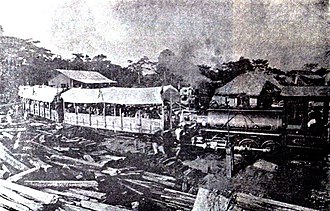Gran Ferrocarril del Táchira
| Gran Ferrocarril del Táchira | |||||||||||||||||||||||||
|---|---|---|---|---|---|---|---|---|---|---|---|---|---|---|---|---|---|---|---|---|---|---|---|---|---|
|
First trip on March 1, 1895 with three
freight cars covered with wood and tarpaulin and decorated with national flags, as the American passenger cars had not yet arrived | |||||||||||||||||||||||||
| Route length: | 120 km | ||||||||||||||||||||||||
| Gauge : | 1000 mm ( meter gauge ) | ||||||||||||||||||||||||
| Maximum slope : | 20 ‰ | ||||||||||||||||||||||||
| Minimum radius : | 80 m | ||||||||||||||||||||||||
|
|||||||||||||||||||||||||
The Gran Ferrocarril del Táchira was a 120-kilometer-long meter-gauge railway in Venezuela that was operated from 1895 to 1955.
Track construction
The track had a track width of 1000 mm. The rail weight per meter was 20 kg / m (40 pounds / yard) and the maximum incline was 2 percent with a minimum curve radius of 80 meters.
Route
The Gran Ferrocarril del Táchira ran from Encontrados on the Río Catatumbo , which was navigable upwards from Lake Maracaibo for steamships with shallow drafts around 1922 , in a southerly direction to its end point at La Uraca station in the direction of San Cristóbal , the capital of the state of Táchira . It was the main traffic connection for the Venezuelan state of Táchira and the passenger traffic of the Colombian department of Norte de Santander .
There were six bridges with a total length of 332 meters. 110 kilometers of the route ran through fairly flat terrain, but the last 10 kilometers of the route were in a promontory.
The average construction cost per kilometer were only 61,135 Bolívar indicated (11,799 $) for the first 110 kilometers of the route, but the cost of another 10 kilometers averaged 93.333 Bolívar ($ 18,013).
Rail vehicles
There were 7 locomotives (with an average weight of 30 tons), 6 passenger wagons, 34 flat wagons, 32 covered wagons and 4 animal transport wagons.
Rates
The 1922 passenger rate was 6.8 cents / mile for first class and 3.4 cents / mile for second class. The freight tariff for export to the north was 21 cents per ton mile, and the freight tariff for import to the south was 5 cents per ton mile.
Traffic volume
The amount of freight transported each year varied greatly depending on the price and size of the local coffee harvest. In 1902 the railway carried a total of 11,113 tons and in 1903 even 27,582 tons, the latter being the highest tonnage ever transported. Passenger traffic rose from just over 1,000 people to the high number of 19,070 in 1919.
financing
The company's registered capital was 7,000,000 bolívar ($ 1,351,000), fully paid. American investors owned some of the share capital, and contrary to Venezuelan rule, almost all of the material and equipment was American-made.
Due to the moderate investment costs and the low construction costs, the share of this railroad was 10.88 percent in 1913, compared to 8 percent for the next best railroad. The main difficulties of this route lay in the floods of the Catatumbo River, which threatened to destroy the river port of Encontrados. The main obstacle to the growth in traffic has been the fact that the goods destined for their territory have to go through so many transshipment operations on their way that costs increase sharply and consumption decreases accordingly.
Gross income for 1919 was 1,571,381 bolívar ($ 303,277) and operating expenses were 625,638 bolívar ($ 120,748).
Individual evidence
- ↑ a b c d e f United States. Bureau of Foreign and Domestic Commerce: Special Agents Series, Issue 212. US Government Printing Office, 1922. pp. 218-219.
- ↑ El "Gran Ferrocarril del Táchira" .
Coordinates: 9 ° 10 ′ 41 ″ N , 72 ° 14 ′ 9 ″ W.
